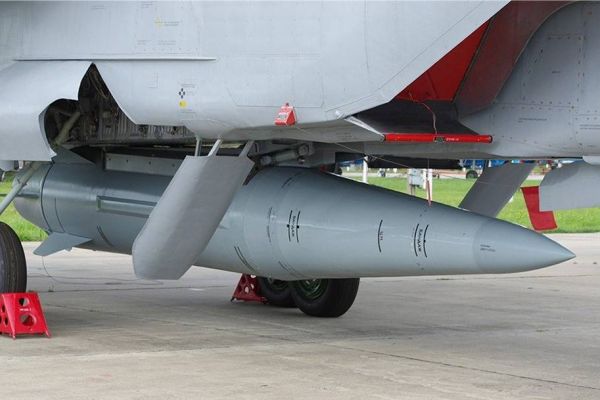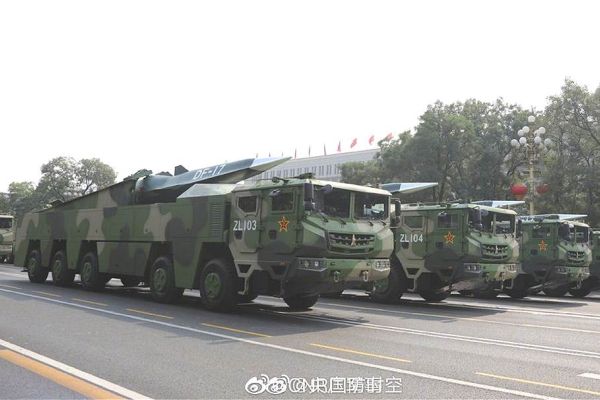Hypersonic Missiles.
Hwasong-16B.

The Hwasong-16B is a hypersonic-capable intermediate-range ballistic missile (IRBM) developed and produced by North Korea. It represents the most advanced missile system in the Hwasong series, combining cutting-edge propulsion technology, advanced mobility, and hypersonic capabilities. Unveiled publicly during a flight test on April 2, 2024, the missile is designed for strategic deterrence and precision long-range nuclear or conventional strike missions. Its advanced hypersonic glide vehicle (HGV) payload, capable of evading missile defenses, has made it a cornerstone of North Korea’s strategic arsenal.
Country users: North Korea
Description
The Hwasong-16B is a hypersonic-capable Intermediate-Range Ballistic Missile (IRBM) developed and produced by North Korea. It is designed to deliver nuclear or conventional warheads over intercontinental ranges while remaining capable of evading advanced missile defense systems. Developed under the auspices of the Korean Workers' Party, its design and production likely began in the late 2010s, leveraging technologies from the Hwasong-15 and Hwasong-17 programs. The missile incorporates advanced solid and liquid propulsion systems and entered service following a successful public flight test in April 2024.
The missile’s primary missions include long-range nuclear deterrence and striking strategic infrastructure, including moving and relocatable targets. The Hwasong-16B has undergone several high-profile tests, including a Hypersonic Glide Vehicle (HGV) test in April 2024, a maneuverable reentry vehicle (MaRV) test in January 2024, and a multiple independently targetable reentry vehicle (MIRV) test in June 2024. Each test demonstrated the missile's versatility and operational potential, particularly its ability to evade interception.
The system employs a two-stage booster for propulsion and a boost-glide vehicle that separates at the first peak of its trajectory. The glide vehicle’s high-speed maneuverability and shallow atmospheric flight path allow it to evade detection and interception, posing a significant challenge to modern missile defense systems. The missile’s latest deployment has demonstrated its capacity to engage distant and dynamic threats with precision.
Hwasong-16B Hypersonic IRBM variants:
- Hwasong-16B HGV Variant (Hypersonic Glide Vehicle): A hypersonic glide vehicle-equipped model capable of separating at the missile’s first peak trajectory. The HGV travels at speeds above Mach 5 along a shallow atmospheric flight path, with high maneuverability to evade missile defenses. Onboard sensors enable it to track and strike moving or relocatable targets. This variant has a range of 3,000 to 5,500 kilometers, making it a direct threat to U.S. military bases in Japan and Guam.
- Hwasong-16B MaRV Variant (Maneuverable Reentry Vehicle): This model features a maneuverable reentry vehicle optimized for evasive maneuvers during the terminal phase of flight. Its aerodynamic design allows it to change course and altitude, making interception difficult. The MaRV variant has a range exceeding 13,000 kilometers and is suited for intercontinental nuclear strikes against well-defended targets.
- Hwasong-16B MIRV Variant (Multiple Independently Targetable Reentry Vehicles): A multiple independently targetable reentry vehicle-equipped version, capable of deploying several warheads to strike distinct targets simultaneously. This variant is designed to overwhelm missile defense systems and enhance strategic deterrence. It retains an intercontinental range of over 13,000 kilometers.
Technical Data
-
Launcher Vehicle
The Hwasong-16B is launched from a 14-wheel transporter erector launcher (TEL) designated as the Hwasongpho-16B. The TEL features a ruggedized chassis for mobility across various terrains, enabling the missile to be deployed from concealed or dispersed locations. The launch canister includes a clamshell section at the front that protects the boost-glide vehicle during transport and storage.
The TEL employs a cold-launch system, with a gas generator ejecting the missile from the canister before the first-stage ignition. This design reduces structural stress on the launcher and improves safety during deployment. The clamshell section opens just before launch, revealing the boost-glide vehicle, which is otherwise protected from environmental conditions.
-
Missile
The Hwasong-16B is a two-stage hypersonic IRBM (Intermediate-Range Ballistic Missile) capable of delivering a variety of advanced payloads, including Hypersonic Glide Vehicles (HGVs), Maneuverable Reentry Vehicles (MaRVs), and Multiple Independently targetable Reentry Vehicles (MIRVs). The missile features a two-stage booster section and a detachable glide vehicle.
The missile has an estimated range exceeding 13,000 kilometers in standard configurations, allowing it to target the continental United States. Hypersonic variants have a slightly reduced range of 3,000 to 5,500 kilometers, but their enhanced evasive capabilities make them particularly effective against U.S. military bases in Japan and Guam. The boost-glide vehicle, released at the first peak of its trajectory, travels at speeds exceeding Mach 5 (approximately 6,000 km/h) along a relatively shallow atmospheric flight path. Its high speed, coupled with its ability to climb, descend, and erratically change course, complicates detection and tracking, as well as interception.
The glide vehicle is equipped with sensors capable of tracking moving and relocatable targets, enabling precision engagement even against dynamic threats. The MaRV configuration, tested in January 2024, features an aerodynamic head section designed for independent terminal-phase maneuvering, increasing survivability. The MIRV configuration, tested in June 2024, deploys multiple warheads to strike distinct targets simultaneously, further enhancing the missile’s lethality.
-
Mobility
The Hwasong-16B relies on the Hwasongpho-16B TEL (Transporter Erector Launcher), which is a robust, 14-wheel heavy-duty truck platform. This TEL is powered by a high-performance diesel engine, providing sufficient torque to carry the missile across rugged terrain and to pre-surveyed launch sites. Its off-road capabilities enable the system to operate from concealed and dispersed locations, complicating adversary tracking efforts.
The TEL has an operational range of approximately 1,000 kilometers on a full fuel load, allowing for independent or battery-level redeployment. This mobility ensures the survivability of the missile system against preemptive strikes and increases its flexibility during operations.
-
Commaand and Control Systems
The Hwasong-16B missile battery includes multiple components. A command and control vehicle coordinates launch operations and integrates secure communications to ensure reliable execution. A radar vehicle provides pre-launch environmental assessments and tracks airborne threats. Additional support vehicles, including fuel trucks, mobile cranes, and maintenance units, are essential for logistical and operational support.
North Korea’s command and control systems are designed for redundancy, incorporating underground facilities and decentralized nodes to ensure continued functionality even under attack. This enhances the system's operational resilience and strategic reliability.
-
Combat use
The Hwasong-16B is engineered for strategic deterrence and long-range strike missions, capable of delivering nuclear or conventional payloads to global targets. Its hypersonic capabilities and advanced payload options make it particularly effective at countering modern missile defense systems.
With a range exceeding 13,000 kilometers in its standard configuration, the missile can engage intercontinental targets, including those in the continental United States. The hypersonic warhead, with a range of 3,000 to 5,500 kilometers, places U.S. military bases in Japan and Guam within striking distance. The boost-glide vehicle’s ability to maneuver unpredictably at hypersonic speeds further complicates interception, ensuring the missile’s effectiveness even against advanced missile defenses.
The integration of hypersonic glide vehicles, maneuverable reentry vehicles, and multiple warheads provides the Hwasong-16B with unmatched versatility and lethality. These features enable it to engage static and mobile targets with precision, delivering devastating results. As a key component of North Korea’s strategic missile forces, the Hwasong-16B significantly enhances the nation’s ability to project power, deter adversaries, and assert its presence on the global stage.
Specifications
-
Type
Hypersonic-capable Intermediate-Range Ballistic Missile (IRBM)
-
Country users
North Korea
-
Designer Country
North Korea
-
Warhead Missile
- Nuclear: Capable of carrying a hypersonic glide vehicle (HGV), maneuverable reentry vehicle (MaRV), or multiple independently targetable reentry vehicles (MIRVs).
- Conventional: Potential capability for high-precision conventional strikes. -
Accuracy
Estimated Circular Error Probable (CEP) of hundreds of meters, with MaRV and HGV configurations offering increased precision for relocatable or moving targets.
-
Range Missile
- Standard Configuration: Over 13,000 km (Intercontinental range).
- Hypersonic Variant (HGV): 3,000 to 5,500 km (Regional range). -
Missile Launch Weight
Estimated at 80,000 to 100,000 kg, including the payload and fuel.
-
Speed Missile
Mach 5 (hypersonic) for HGV (Hypersonic Glide Vehicle) configuration, with peak speeds potentially reaching Mach 20 during the midcourse phase.
-
Altitude Missile
- Maximum altitude: Over 1,000 kilometers during ballistic flight tests.
- Operational HGV trajectory: Shallow flight path within the atmosphere. -
Dimensions Missile
Approximately Length: 26-27 m; Diameter: 2.9 m; Fin Span: Not publicly disclosed but estimated at 4-5 meters for aerodynamic stabilization.











































